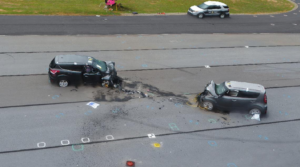 Thanks to the Wright Brothers’ well-known maiden voyage, North Carolina is called the First in Flight State. True to the motto, the Tarheel State (which is a very totally different origin story!) continues to take the lead in drone innovation.
Thanks to the Wright Brothers’ well-known maiden voyage, North Carolina is called the First in Flight State. True to the motto, the Tarheel State (which is a very totally different origin story!) continues to take the lead in drone innovation.
The state Department of Transportation launched a feasibility research final week with a plan to use drones to create 3D fashions of auto crash scenes.
Released by the DOT’s Division of Aviation’s Unmanned Aircraft Systems (UAS) Program, the State Highway Patrol, and the NCDOT Photogrammetry Unit, the report states that “current methods of investigating collisions can be time consuming and require highway closures.”
During a current coaching occasion wherein a collision was simulated, a drone crew lowered the time wanted to carry out an correct reconstruction from 1 hour 51 minutes to simply 25 minutes.
“Crews would be able to start clearing the scene of a collision more than an hour earlier, and that means traffic can start moving that much faster. Drones also significantly reduce the risk posed to personnel involved, provide an aerial perspective of the scene, and are cheaper and easier to use than current technologies,” the report detailed.
The flight crew mapped the “crash scene” with a DJI Mavic Pro, DJI Phantom four Pro and DJI Inspire 2 in autonomous and semiautonomous flight modes at 90-100 ft above floor degree. Each flight captured between 60 and 81 photos and three flights have been accomplished in underneath 25 minutes. The crew then processed the outcomes utilizing Agisoft PhotoScan software program.
The report recommends that the State Highway Patrol “integrate UAS into its collision scene reconstruction units to help improve the safety and efficiency of our state’s roadway system and conduct additional research to examine how UAS compares to legacy methods during inclement weather and nighttime conditions.”
In April, NCDOT created a set of greatest practices for drone use in catastrophe evaluation, search-and-rescue and different authorities responses. The last report was launched after NCDOT’s Division of Aviation held a workshop with emergency administration officers.
The workshop highlighted the Airspace Integration Table Top Exercise by North Carolina State University’s NextGen Air Transportation (NGAT) Consortium. The train built-in drone use into catastrophe response preparedness planning and was designed to “identify command and control requirements, provide potential users with situational experience with UAS, and provide test cases for evaluating policy and regulations related to UAS management at the state level.”
 Unmanned Aerial Vehicle The latest drone news
Unmanned Aerial Vehicle The latest drone news
